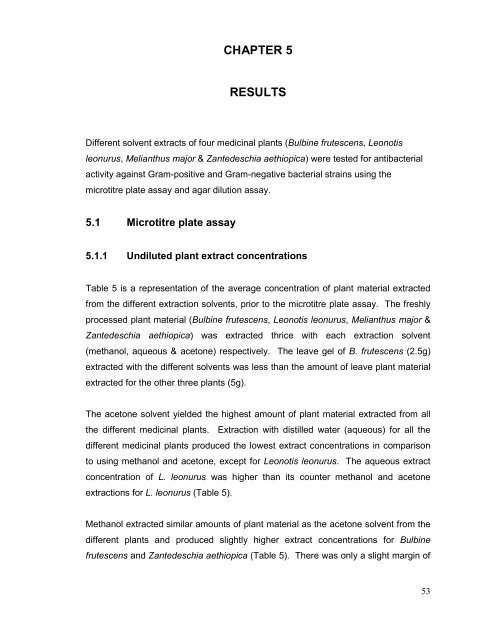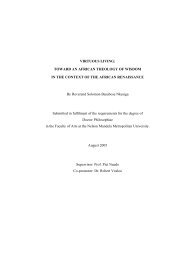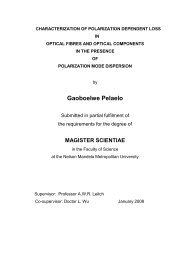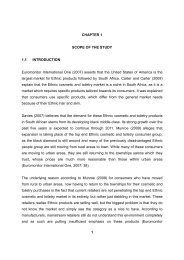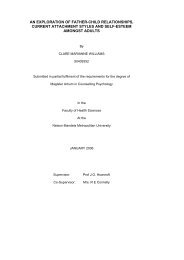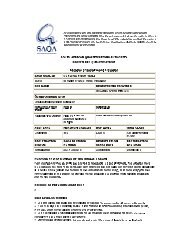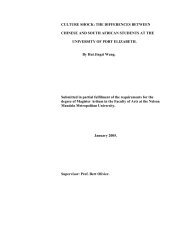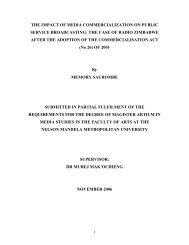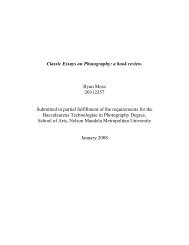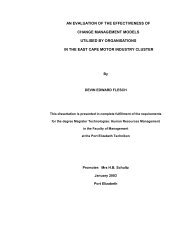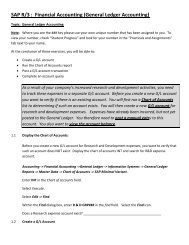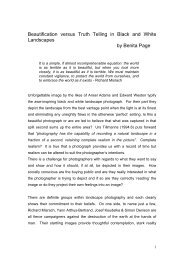an investigation into the antibacterial activities of medicinal plants ...
an investigation into the antibacterial activities of medicinal plants ...
an investigation into the antibacterial activities of medicinal plants ...
You also want an ePaper? Increase the reach of your titles
YUMPU automatically turns print PDFs into web optimized ePapers that Google loves.
CHAPTER 5<br />
RESULTS<br />
Different solvent extracts <strong>of</strong> four <strong>medicinal</strong> pl<strong>an</strong>ts (Bulbine frutescens, Leonotis<br />
leonurus, Meli<strong>an</strong>thus major & Z<strong>an</strong>tedeschia aethiopica) were tested for <strong>an</strong>tibacterial<br />
activity against Gram-positive <strong>an</strong>d Gram-negative bacterial strains using <strong>the</strong><br />
microtitre plate assay <strong>an</strong>d agar dilution assay.<br />
5.1 Microtitre plate assay<br />
5.1.1 Undiluted pl<strong>an</strong>t extract concentrations<br />
Table 5 is a representation <strong>of</strong> <strong>the</strong> average concentration <strong>of</strong> pl<strong>an</strong>t material extracted<br />
from <strong>the</strong> different extraction solvents, prior to <strong>the</strong> microtitre plate assay. The freshly<br />
processed pl<strong>an</strong>t material (Bulbine frutescens, Leonotis leonurus, Meli<strong>an</strong>thus major &<br />
Z<strong>an</strong>tedeschia aethiopica) was extracted thrice with each extraction solvent<br />
(meth<strong>an</strong>ol, aqueous & acetone) respectively. The leave gel <strong>of</strong> B. frutescens (2.5g)<br />
extracted with <strong>the</strong> different solvents was less th<strong>an</strong> <strong>the</strong> amount <strong>of</strong> leave pl<strong>an</strong>t material<br />
extracted for <strong>the</strong> o<strong>the</strong>r three pl<strong>an</strong>ts (5g).<br />
The acetone solvent yielded <strong>the</strong> highest amount <strong>of</strong> pl<strong>an</strong>t material extracted from all<br />
<strong>the</strong> different <strong>medicinal</strong> pl<strong>an</strong>ts. Extraction with distilled water (aqueous) for all <strong>the</strong><br />
different <strong>medicinal</strong> pl<strong>an</strong>ts produced <strong>the</strong> lowest extract concentrations in comparison<br />
to using meth<strong>an</strong>ol <strong>an</strong>d acetone, except for Leonotis leonurus. The aqueous extract<br />
concentration <strong>of</strong> L. leonurus was higher th<strong>an</strong> its counter meth<strong>an</strong>ol <strong>an</strong>d acetone<br />
extractions for L. leonurus (Table 5).<br />
Meth<strong>an</strong>ol extracted similar amounts <strong>of</strong> pl<strong>an</strong>t material as <strong>the</strong> acetone solvent from <strong>the</strong><br />
different pl<strong>an</strong>ts <strong>an</strong>d produced slightly higher extract concentrations for Bulbine<br />
frutescens <strong>an</strong>d Z<strong>an</strong>tedeschia aethiopica (Table 5). There was only a slight margin <strong>of</strong><br />
53


